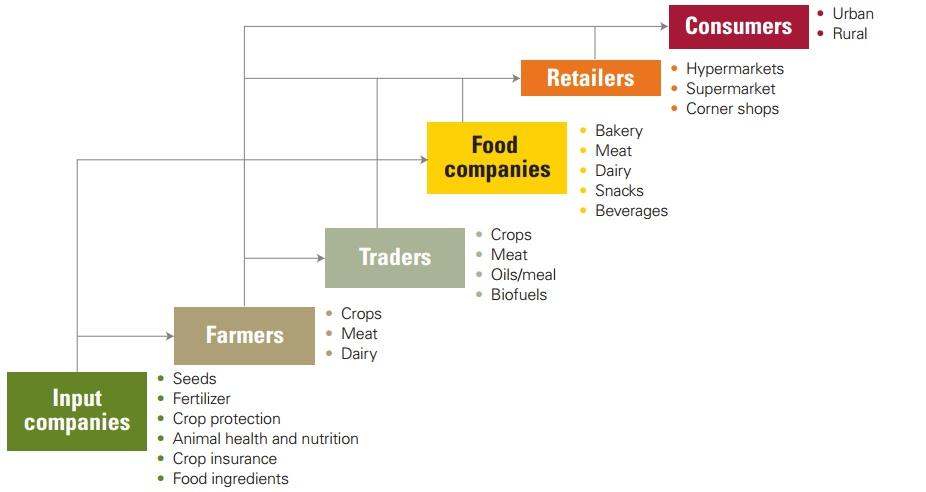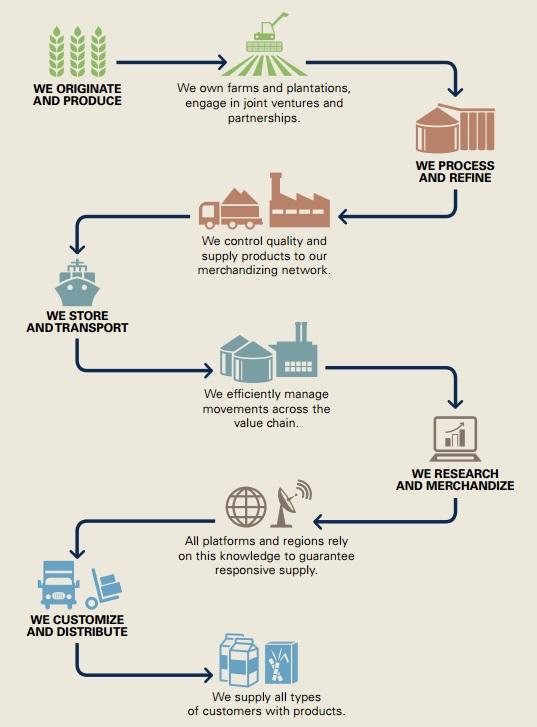Louis Dreyfus Company (LDC) is one of the largest merchants and processors of agricultural products in a world (LDC, 2017a). The company also operates a global network of subsidiaries that are involved in international shipping, telecommunications, finance, and real estate development among others (LDC, 2017a). Each year it processes more than 80 million tons of agricultural goods and serves approximately 500 million customers (LDC, 2017a).
As of 2016, the company employed up to 21, 000 people worldwide (LDC, 2017a). The company’s values include commitment, humility, diversity, and entrepreneurship. Judging from LDC’s vision, which states “to work towards a safe and sustainable future, contributing to the global effort of providing sustenance for a growing population” (LDC, 2017b, para. 1), it is also driven by the commitment to sustainability.
The company’s desire to be committed to sustainability is especially important in the era when many businesses struggle with moderating their impact on the environment and societies. While it is necessary for corporate citizens to keep abreast of modern economic trends, it is also important not to forget about the moral importance of social imperatives. The aim of this paper is to develop a strategic plan for the integration of social responsibility into LDC’s strategic value proposition and value chain.
Overview of Corporate Social Responsibility
Corporate social responsibility (CSR) can be defined as “the way firms integrate social, environmental and economic concerns into their values, culture, decision making, strategy and operations in a transparent and accountable manner and thereby establish better practices within the firm, create wealth and improve society” (Chandler & Werther, 2013, p. 21). The core CSR activities go far beyond the sphere of legal requirements and regulations for sustainable business development and encompass such areas as corporate governance and ethics, environmental stewardship, sustainable development, industrial relations, community involvement, corporate philanthropy, and supplier relations among others (Hopkins, 2012).
Companies that are willing to find sustainable solutions for their business processes are increasingly shifting towards the circular economy as a means of reducing waste and changing the pattern of raw materials usage (Tse, Esposito, & Soufani, 2016).
Implementation of CSR Policies
According to Hopkins (2012), almost every process in a company’s value chain is related to a variety of social factors that have to be considered. Therefore, managers of LDC have to make sure that the company’s activities in addition to improving its competitive advantage also support social causes (Hopkins, 2012). Figure 1 shows the agribusiness value chain.

LDC specializes in the production, trading, processing, distribution, and retail of agricultural goods. Therefore, its value chain is almost similar to that of the agricultural industry. Figure 2 shows the company’s value chain.

LDC owns numerous components of the value chain; therefore, it is characterized by vertical integration. Taking into consideration the fact that the company has a substantial amount of power in the value chain, it should be the party that will bear the majority of costs of the implementation of CSR policies. However, LDC will also be able to accrue the benefits of the implementation of CSR policies and standards at the producer’s end of the value chain by saving costs of production. At the supplier’s end of the value chain, the company will enjoy the benefits of reputation assurance that will spill over to its strategic value proposition.
In order to integrate social responsibility as a means of achieving sustainability, LDC has to develop a set of internal CSR policies and regulations for every link of its value chain. To this end, the company has to ensure that its code of conduct overlaps with principles of circular economy and sustainability. There are three core principles of circular economy: preserving natural capital, optimizing resource yields, and fostering system effectiveness (World Economic Forum, 2014).
The management of the company will use a set of strategic tools to map social opportunities that have an intersection with these principles. Also, the company will use affirmative CSR agenda to make sure that circular economy principles have a reflection in its strategic value proposition. By mapping the impact of its value chain on society and the environment, LDC will identify inside-out linkages impact of which will be either reduced or eliminated. Specifically, the company will concentrate on the impact of its transportation, emission and waste, packaging use, and disposal of obsolete goods (Porter & Kramer, 2006).
It is necessary to make sure that all subsidiaries of LDC comply with CSR standards. Therefore, the company will promote co-regulation activities the will help to ensure that all of its branches operate according to CSR principles. Another step towards implementing sustainability is to raise awareness among LDC employees about the necessity of the compliance with CSR standards. The company will make sure that its workers are cognizant of internal policies related to sustainability and will empower them to report any cases of violation of these policies.
LDC engages in joint ventures and partnerships with other producers of agricultural goods (LDC, 2017a). It is extremely important to involve them into the implementation of sustainable principles into their business processes. In order to do so, it is necessary to make new policies applicable to their needs and capabilities. To this end, LDC’s partners will be provided with necessary information on the requirements of the company’s CSR policies, standards, and regulations.
Furthermore, both large and small farmers working with the merchant of agricultural goods will be offered incentives to follow the company’s regulations in the form of low-interest loans. The provision of such loans is an important step in LDC’s strategic plan because it will help to “support the viability and diversity of rural economies and communities” (Hopkins, 2012, p. 41).
The integration of social responsibility into the company’s value chain presupposes “respect for the biological limits of natural resources” (Hopkins, 2012, p. 41). By issuing low-interest loans to its partners, the company will be able to incentivize them to adhere to sustainable land management and ensuring safe and hygienic working conditions for their employees.
The company has established its presence in more than 100 countries around the world (LDC, 2017c). Some of the regions in the developing world in which LDC has trading and production hubs are characterized by tensions between working people and elite groups that are willing to explore their labour (Hopkins, 2012). Therefore, CSR standards and regulations of the company will help to ensure that agricultural production practices do not involve forced or compulsory labour, child labour, unfair employment terms, lack of freedom of association, unequal opportunities for women, health and safety risks, discrimination of employees, and violation of human rights (Hopkins, 2012).
Conclusion
The paper outlined a strategic plan for the integration of social responsibility principles into LDC’s strategic value proposition and value chain. The plan will help to ensure that the company shifts towards the circular economy while simultaneously improving its competitive advantage.
References
Chandler, D., & Werther, W. (2013). Strategic corporate social responsibility: Stakeholders, globalizations, and sustainable value creation. New York, NY: SAGE Publications.
Hopkins, M. (2012). Corporate social responsibility and international development: Is business the solution? London, England: Earthscan.
KPMG. (2013). The agricultural and food value chain: Entering a new era of cooperation. Web.
LDC. (2015). Annual report 2015. Web.
LDC. (2017a). About us. Web.
LDC. (2017b). Vision and values. Web.
LDC. (2017c). Locations. Web.
Porter, M., & Kramer, M. (2006). Strategy and society: The link between competitive advantage and corporate social responsibility. Harvard Business Review. Web.
Tse, T., Esposito, M., & Soufani, K. (2016). How businesses can support a circular economy. Harvard Business Review. Web.
World Economic Forum. (2014). Towards the circular economy: Accelerating the scale-up across global supply chains. Web.